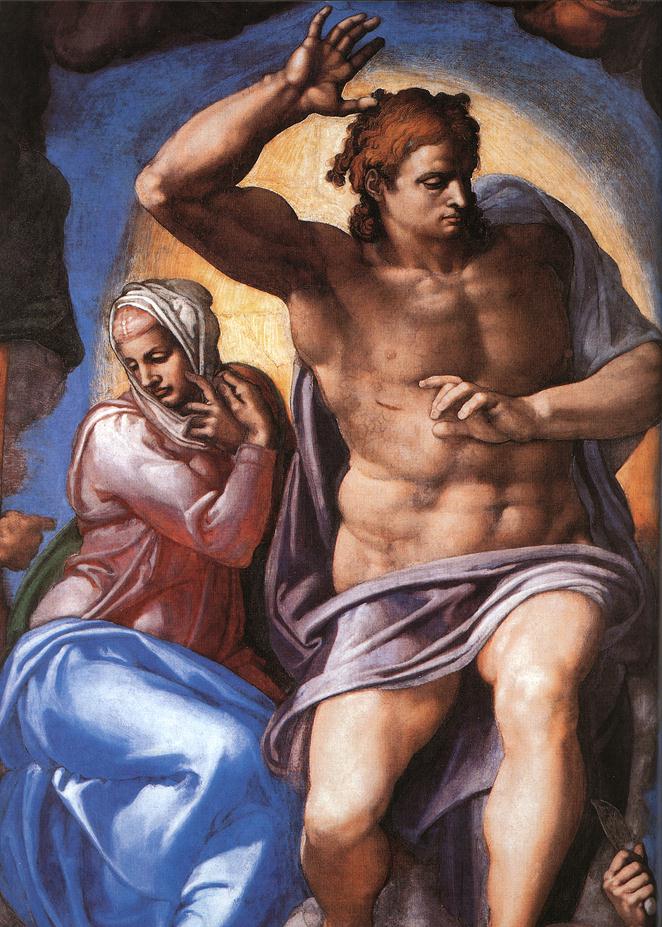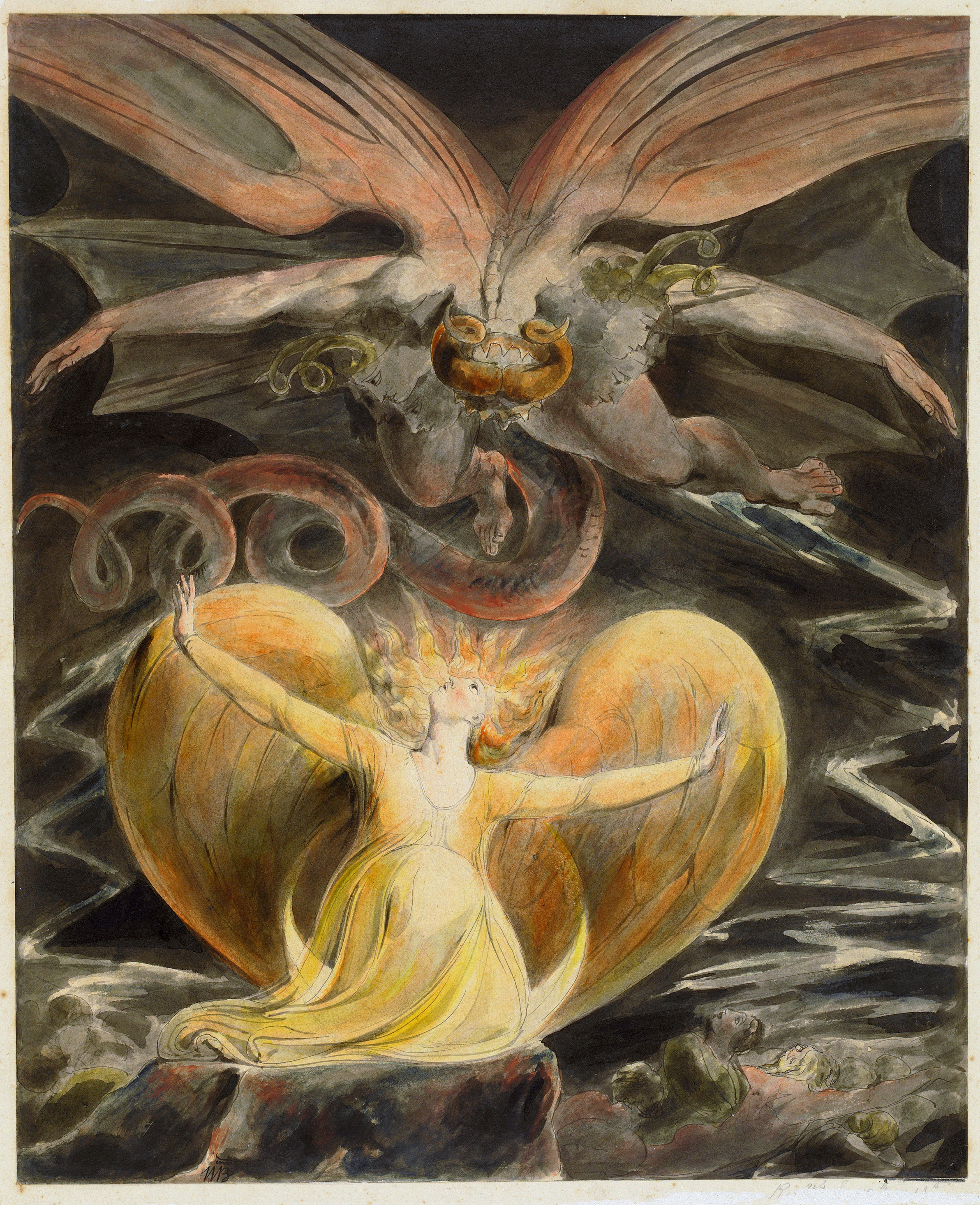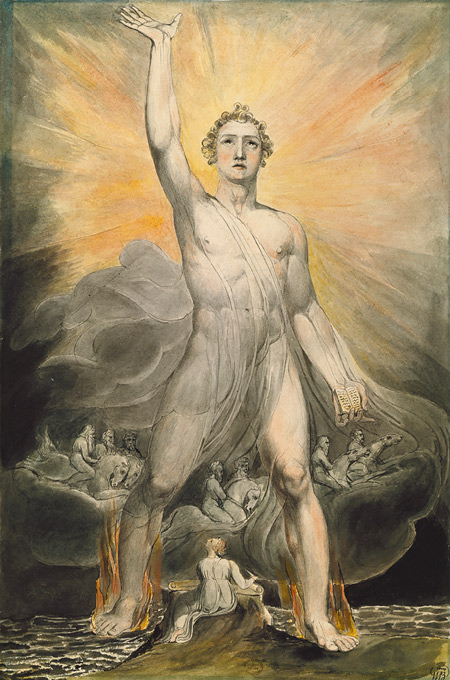The
book of Revelation was important to Blake for multiple reasons.
Primarily as a book of visions which Blake himself experienced as
communications from God. Furthermore John of Patmos was giving an
account of the new world which would replace the world of sin and death
in which we live. Blake used the sleep of Albion as a symbol for the "passage through Eternal Death" until the breath Divine begins the process of restoration of the unity of all things.
John of Patmos and William Blake both used symbolic language to convey spiritual truth.
Jerusalem, Plate 4, (E 146)
"Of the Sleep of Ulro! and of the passage through
Eternal Death! and of the awaking to Eternal Life.
This theme calls me in sleep night after night, & ev'ry morn
Awakes me at sun-rise, then I see the Saviour over me
Spreading his beams of love, & dictating the words of this mild song.
Awake! awake O sleeper of the land of shadows, wake! expand!
I am in you and you in me, mutual in love divine:
Fibres of love from man to man thro Albions pleasant land.
In all the dark Atlantic vale down from the hills of Surrey
A black water accumulates, return Albion! return!
Thy brethren call thee, and thy fathers, and thy sons,
Thy nurses and thy mothers, thy sisters and thy daughters
Weep at thy souls disease, and the Divine Vision is darkend:"
Four Zoas, Night VII, Page 87, (E 369)
"But This Union
Was not to be Effected without Cares & Sorrows & Troubles
Of six thousand Years of self denial and of bitter Contrition
Revelation 21
[22] And I saw no temple therein: for the Lord God Almighty and the Lamb are the temple of it.
[23]
And the city had no need of the sun, neither of the moon, to shine in
it: for the glory of God did lighten it, and the Lamb is the light
thereof.
[24] And the nations of them which are saved shall
walk in the light of it: and the kings of the earth do bring their glory
and honour into it.
[25] And the gates of it shall not be shut at all by day: for there shall be no night there.
[26] And they shall bring the glory and honour of the nations into it.
 |
British Museum St John the Evangelist before a vision of Christ |
This is the passage illustrated by the image:
Revelation 1
[9] I John, who also am your brother, and companion in
tribulation, and in the kingdom and patience of Jesus Christ, was in the
isle that is called Patmos, for the word of God, and for the testimony
of Jesus Christ.
[10] I was in the Spirit on the Lord's day, and heard behind me a great voice, as of a trumpet,
[11]
Saying, I am Alpha and Omega, the first and the last: and, What thou
seest, write in a book, and send it unto the seven churches which are in
Asia; unto Ephesus, and unto Smyrna, and unto Pergamos, and unto
Thyatira, and unto Sardis, and unto Philadelphia, and unto Laodicea.
[12] And I turned to see the voice that spake with me. And being turned, I saw seven golden candlesticks;
[13]
And in the midst of the seven candlesticks one like unto the Son of
man, clothed with a garment down to the foot, and girt about the paps
with a golden girdle.
[14] His head and his hairs were white like wool, as white as snow; and his eyes were as a flame of fire;
[15] And his feet like unto fine brass, as if they burned in a furnace; and his voice as the sound of many waters.
[16]
And he had in his right hand seven stars: and out of his mouth went a
sharp twoedged sword: and his countenance was as the sun shineth in his
strength.
[17] And when I saw him, I fell at his feet as dead.
And he laid his right hand upon me, saying unto me, Fear not; I am the
first and the last:
[18] I am he that liveth, and was dead; and, behold, I am alive for evermore, Amen; and have the keys of hell and of death.
[19] Write the things which thou hast seen, and the things which are, and the things which shall be hereafter;
[20]
The mystery of the seven stars which thou sawest in my right hand, and
the seven golden candlesticks. The seven stars are the angels of the
seven churches: and the seven candlesticks which thou sawest are the
seven churches.
Hebrews 4
[12] For the word of God is quick, and powerful, and sharper than any twoedged sword,
piercing even to the dividing asunder of soul and spirit, and of the
joints and marrow, and is a discerner of the thoughts and intents of the
heart.
In Ego and Archetype, Edward F Edinger wrote this about signs and symbols on page 109:
"Man
needs a world of symbols as well as a world of signs. Both sign and
symbol are necessary but should not be confused with one another. A sign
is a token of meaning that stands for a known entity. By
this definition, language is a system of signs, not symbols. A symbol on
the other hand, is an image or representation which points to something
essentially unknown, a mystery. A sign conveys abstract,objective
meaning whereas a symbol conveys living, subjective meaning. A symbol
has a subjective dynamism which exerts a powerful attraction and
fascination on the individual. It is a living, organic entity which acts
as a releaser and transformer of psychic energy. We may say that a sign
is dead, but a symbol is alive.
...
The
archetypal psyche is constantly creating a steady stream of living
symbolic imagery. Ordinarily this stream of images is not consciously
perceived except through dreams or through waking fantasy when the
conscious level of attention has been lowered. However, there is reason
to believe that even in the full waking state this system of symbols
charged with effective energy continues to flow beyond the notice of the
ego."
These are the passages in which Blake mentioned Patmos or Revelations:
Milton, Plate 40 [46], (E 141)
"No sooner she had spoke but Rahab Babylon appeard
Eastward upon the Paved work across Europe & Asia
Glorious as the midday Sun in Satans bosom glowing:
A Female hidden in a Male, Religion hidden in War
Namd Moral Virtue; cruel two-fold Monster shining bright
A Dragon red & hidden Harlot which John in Patmos saw
And all beneath the Nations innumerable of Ulro
Appeard, the Seven Kingdoms of Canaan & Five Baalim
Of Philistea. into Twelve divided, calld after the Names
Of Israel: as they are in Eden. Mountain. River & Plain
City & sandy Desart intermingled beyond mortal ken
But turning toward Ololon in terrible majesty Milton
Replied. Obey thou the Words of the Inspired Man
All that can be annihilated must be annihilated
That the Children of Jerusalem may be saved from slavery"
Four Zoas, Night VIII, Page 114, (E 385)
"And Los & Enitharmon took the Body of the Lamb
Down from the Cross & placd it in a Sepulcher which Los had hewn
For himself in the Rock of Eternity trembling & in despair
Jerusalem wept over the Sepulcher two thousand Years
PAGE 115 [111]
Rahab triumphs over all she took Jerusalem
Captive A Willing Captive by delusive arts impelld
To worship Urizens Dragon form to offer her own Children
Upon the bloody Altar. John Saw these things Reveald in Heaven
On Patmos Isle & heard the Souls cry out to be deliverd
He saw the Harlot of the Kings of Earth & saw her Cup
Of fornication food of Orc & Satan pressd from the fruit of Mystery
But when she saw the form of Ahania weeping on the Void
And heard Enions voice sound from the caverns of the Grave
No more spirit remained in her She secretly left the Synagogue of Satan"
Jerusalem, Plate 48, (E 196)
"In silence the Divine Lord builded with immortal labour,
Of gold & jewels a sublime Ornament, a Couch of repose,
With Sixteen pillars: canopied with emblems & written verse.
Spiritual Verse, order'd & measur'd, from whence, time shall reveal.
The Five books of the Decologue, the books of Joshua & Judges,
Samuel, a double book & Kings, a double book, the Psalms & Prophets
The Four-fold Gospel, and the Revelations everlasting"
Vision of Last Judgment, Page 80, (E 558)
"Four Angels descend headlong with four trumpets to
awake the Dead. beneath these is the Seat of the Harlot <namd>
Mystery in the Revelations. She is [bound] siezed by
Two Beings each with three heads they Represent Vegetative
Existence. <as> it is written in Revelations they strip her naked
& burn her with fire <it represents the Eternal Consummation of
Vegetable Life & Death with its Lusts The wreathed Torches in
their hands represents Eternal Fire which is the fire of
Generation or Vegetation it is an Eternal Consummation Those who
are blessed with Imaginative Vision see This Eternal Female &
tremble at what others fear not while they <despise &> laugh at
what others fear> <Her Kings & Councellors & Warriors descend in
Flames Lamenting & looking upon her in astonishment & Terror. &
Hell is opend beneath her Seat on the Left hand>. beneath her
feet is a flaming Cavern in which is seen the Great Red Dragon
with Seven heads & ten Horns [who] <he has Satans book
of Accusations lying on the rock open before him> <he> is bound
in chains by Two strong demons they are Gog & Magog"
Vision of Last Judgment, Page 83, (E 561)
"The Cloud that opens rolling apart before the throne &
before the New Heaven & the New Earth is Composed of Various
Groupes of Figures particularly the Four Living Creatures
mentiond in Revelations as Surrounding the Throne these I suppose
to have the chief agency in removing the
old heavens & the old Earth to make way for the New Heaven & the
New Earth to descend from the throne of God & of the Lamb. that
Living Creature on the Left of the Throne Gives to the Seven
Angels the Seven Vials of the wrath of God <with> which they
hovering over the Deeps beneath pour out upon the wicked their
Plagues the Other Living Creatures are descending with a Shout &
with the Sound of the Trumpet Directing the Combats in the upper
Elements"





.jpg)




